
Custom shirtmaker CEGO's Carl Goldberg shared a few garments from his father's wardrobe with us, one of which is a DB jacket (pants long lost) made by Gilbert Feruch, some time in the seventies, I think.
I gather he was something of a futurist, and the V&A museum has a Nehru suit that he made on display. Other than that, I know practically nothing about him. What I find most interesting about this garment is that had he removed the label, I would have sworn it was a Smalto, the garment we recently looked at. There are so many details which are virtually identical that it is impossible that the two were not somehow linked at some point in their careers. I won't speculate on that link but if someone has more information I would love to hear it.
While I was surprised to have seen a two-piece top collar on a piece of bespoke work, here is another one.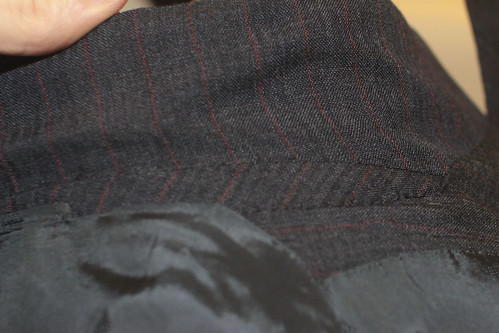
The buttonholes are fairly good, though they may have seen better days, particularly the Milanaise which looks to have had a flower or two through it.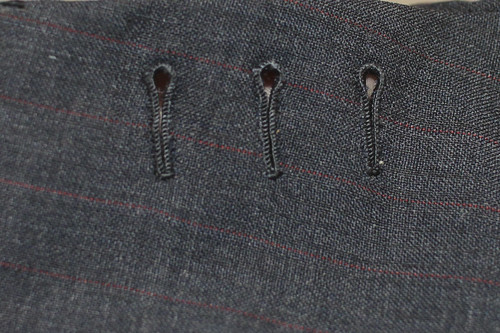
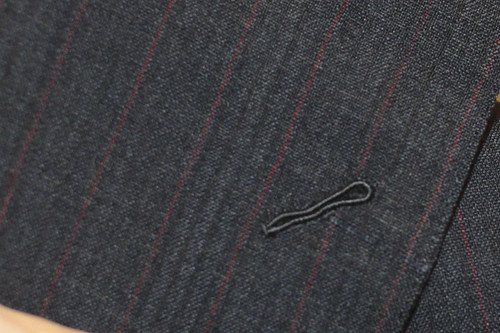
This is how buttons should be sewn on.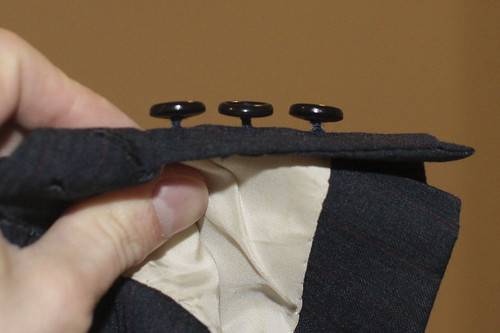
Like the Smalto, the pocket jets have been stitched by hand. The breast welt and its facing have also been constructed by hand, and sewn through the chest piece.
While the interior finishing on many of the coats we have looked at has seemed like an afterthought, Feruch is clearly making a statement here.
Again, pocket jets done by hand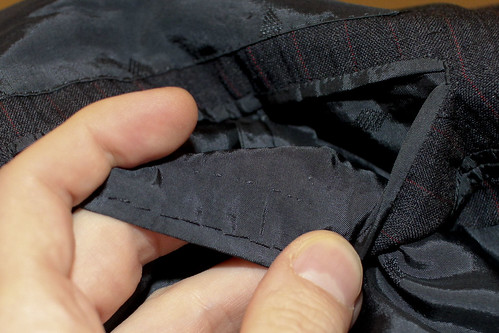
The lining has been inserted by hand and stitched up in an identical fashion to the Smalto.
Even this diagonal tack is identical.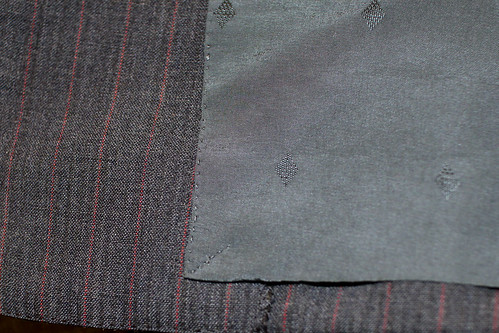
While the Smalto had wiggan in the vents, this one has silesia, but cut and inserted identically to the Smalto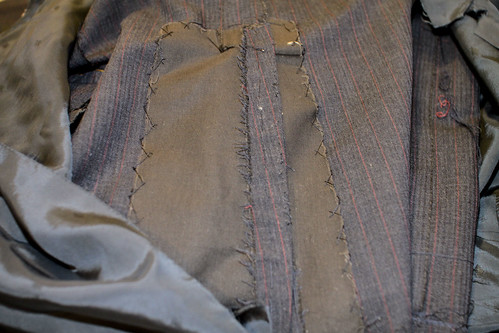
The real differentiator between the two is that the Smalto had been padstitched by machine, and this one has been done by hand.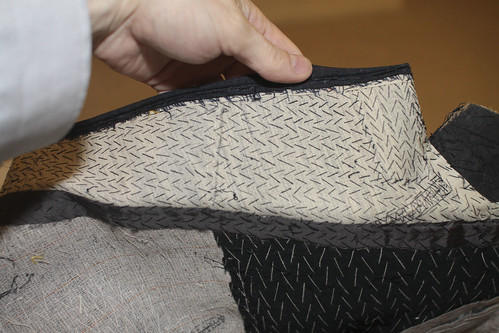
Note how the direction of the stitching was reversed to help with the peak of the lapel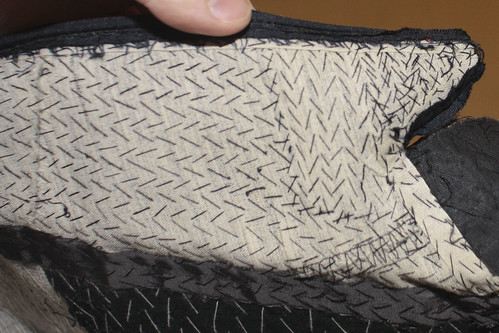
The collar has been padded by hand with a piece of silesia on each end.
The chest and shoulder pad have also been done by hand, and the same kind of cut and reversal of the direction of the grain as I found in the Smalto.
The final detail was that the facings had been drawn on entirely by hand, while the Smalto (like so many others) had been done by machine. And for those who still care, the sleeve was set by machine and the shoulder seam sewn by machine. Absolutely everything else on this coat had been done by hand so clearly they were not looking to save time or cut corners- if they thought there was any benefit to doing these steps by hand they would have been done by hand. But they were not.
Other than the few steps which had been done by machine on the Smalto coat, steps which may have come later to help bring costs down as the Smalto is much more recent than the Feruch, these two coats are so close that they could have been made in the very same workshop.
Intriguing, no? Thoughts, anyone?
And thank you, Carl.








18 comments:
An amazing piece of work, probably the most handwork of all the coats you have examinined. Any benefit to drawing up the facings by hand?
regarding the speculative link with smalto, this one doesn't seem to have the same finesse, at least from the pictures, but a wonderful piece of work nonetheless.
Thank you Carl for donating the coat and thank you Jeffery for ripping it to shreds! The French coats have an attitude and a chutzpa that's lacking in the other garments we've seen here. I especially like the inside pocket arrangement of the Feruch.
@Brendan, the Huntsman coat probably had the most handwork, but this one is far more interesting, especially the change in direction of the padding in the lapel peaks and the silesia at the ends of the collar.
BTW, what is wiggan?
I remember my father wearing this suit quite often.
the fabric which was not discussed, is beautiful. I would assume english. My father always looked quite elegant in this suit. there was a period where my father wore a rosette in his lapel buttonhole. that is why it looks worse for wear.
sadly when I looked through his closet, this suit had no trousers and the moths and eaten it for breakfast.
@ Benjamin E. - As far as I know, wiggan is an interfacing which comes in strips, sort of cotton organdy-ish in weight. It feels like it's been starched, but I think that's just the weave. I bought some online, and can't remember where from... I think it was from here http://www.voguefabricsstore.com/ but they don't seem to stock it now.
It seems like a good thing to use in areas where you want some firmness but still with a bit of flexibility in the seam. Might even be good for something like a sleevehead on a heavy wool? Dunno. I suspect one could get the same effect with just cotton organdy that you cut into bias strips yourself.
I'm interested in the padstitching on the collar. The way I learned it, you start from the center back seam and padstitch back and forth the long way, all the way to the end of the collar and back to the center. Once you do both sides, the pad stitching looks like mirror images (in terms of stitch slanting... gah I'm sure there's a correct term for that.)
On this collar, it seems that the ends of the collar were stitched the long way, but past the silesia, the pad stitching switched to be perpendicular to the long seam around the neck. Suppose there's a good reason for this?
Thanks!
Carl, do you have any photos of your father wearing his Feruch, Lanvin, and Lobbs? You needn't include the face, just how the clothes looked on him. Thank you.
- M
Is there any benefit in having a two piece top collar?
@brendan- The only real benefit of draing on the facings by hand, in my opinion, is that it can make distribution of fullness over the lapel easier, but that is negated by the difficulty of working around the peak.
@s.- true, but they are 20 years apart.
@Benjamin- wiggan is a sort of interfacing usually used in sleeve hems. It's usually sold pre-cut on the bias, on rolls.
@Detlef- I'm not entirely sure what you mean, but yes- that is typical of the way undervents are done. You would only need to keep the seam hidden on the top part of the vent.
@malwae- there are so many different theories on how the collar should be pad stitched, but I think that a properly cut collar will sit tight no matter what.
@Anonymous- a two-piece top collar will fit so much better without the need for stretching and shrinking it- you want length on the outer edges but a short crease line; the undercollar is on the bias so it is easy to mold, the top collar, being cut on the straight, not so much. That's why a seam helps.
Hi jeff, will send you that email (book) as promised today (just in case it ends up in junk folder). Thanks
Hello Jeffrey,
On your blog some time back you took apart two Henry Poole coats and wondered about parts of the construction: the haircloth, the pad-stitching,bagging of the lining etc. Over at Permanent Style the author mentioned he was having a suit made up at Poole's and he's following the construction with photos. I deliberately asked whether he would investigate the construction, in terms of haircloth, stitching (hand vs machine) and what their usual methods are.
Simon Crompton (of Permanent Style) is not a tailor, but an style enthusiast, and he has taken photos of the canvassing and pad-stitching by hand (a little by machine), and the machining of the lapel/collar, which is comments upon thus : "The advantage of using the machine is that it is easy to adjust the tension, which is important in shaping both the lapel and the collar".
I posted this here because email notification reports the account has been disabled(?)
Anyway I thought it might interest you. So here's the link: http://www.permanentstyle.co.uk/2011/04/prince-of-wales-at-henry-poole-part-4.html
@Roger-I'm not quite in agreement with what was written about that...
This is clearly the greatest tailored clothing blog ever written. BTW, in reading your entries on sleeve drape and the A&S "Soft" construction, I remember being in Naples at the Kiton factory (a poor word to describe a fairytale land) and an old tailor caught be eyeballing the subtle gathering at the top of the sleeve. "Grinze grinze, is not mistake" he said, almost on the defensive. It reminded me that everything in a garment like a Kiton jacket is intentional, with nothing left out in laziness. I vacillate between loving the razor accuracy of Brioni and the comfortable, rumpled look of Napoletano tailoring like Kiton. It has been amusing to me over the years to hear the employees from each house argue about why their own style is the best. Same goes for Savile Row.
-M
What was the haircloth situation under the felt?
@Benjamin E.- there was one large piece of wrapped hair and two layers of proper haircloth in the chest (good, firm structure) very much like the Smalto.
J
Okay, okay. Fine. Yeah, I'm groveling.
Lady Gaga is holding a contest in which you write in 1000 words or less why you were "born this way", and if you win you get to be her assistant when she guest-edits-in-chief for Metro publications.
Please go to the URL below to read my submission and vote for it by clicking the facebook "like" button underneath the essay.
THANKS! Also, thanks so much for your comments on my blog! I really like how detailed and into craftsmanship you get on yours. I'll leave a real comment soon!
Sorry for the infomercial...
http://ladygagametro.com/us/view/4vx
Gilbert Feruch is a self taught jewish tailor -born in Oran Algeria ca; 1930.
He was very famous in the 60's.
I'm reading you since few days and I LOOVE your posts
damned! your blog is AMAAAZING!
lately i've been searching some informations about tailoring technique at the library...and finally you've pointed specifically on my problem more than every book did! whow could? hands down!
I specially love your videos (maybe have a word about Casals :( ) anyway you're im my bookmarks now! please keep going XXX...
Sincerely
S.
(didnt wont to pollute your actual posts so feel free to erase this.)
Being formal jodhpuri , Nehru suit is a stand up collar suit with lack of lapels and Nehru collar jacket. Nehru suit
Post a Comment